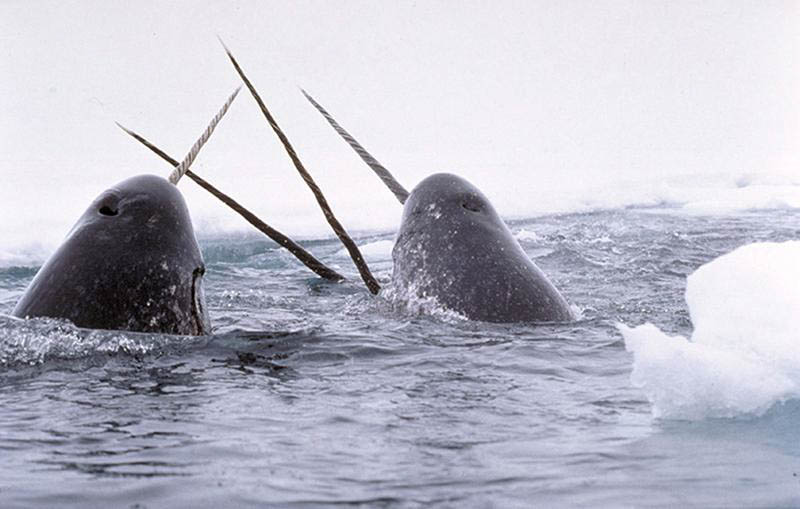Narwhals are an Arctic whale species, commonly identified by their unique tusk which protrudes from their foreheads. This tusk has coined them the nickname “the unicorns of the sea.” They are considered a social species, often travelling in a social group of two to 12 individuals. Narwhals hold great cultural significance and continue to be an important source of food to the indigenous Greenlandic and Canadian Inuit people. Narwhals were historically hunted for their valuable ivory tusks, but today the population size remains healthy and is not of concern.
Narwhals are a medium-sized toothed whale, closely related to the beluga whale (Delphinapterus leucas). They lack a dorsal fin, a trait that likely evolved to improve swimming efficiency under the ice. Narwhals only have two teeth, neither of which are used for feeding. Instead, the right tooth often remains in the skull and at a normal size, while the left forms the distinctive spiralled tusk, often reaching 3 metres in length. This spiralled tusk is most commonly formed in males, although does occasionally develop in females. The tusk itself has millions of nerve endings, making it a highly sensitive tool that plays a large role in the narwhal’s ability to navigate their environment and hunt. There are many additional ideas as to the exact function of the tusk, including its ability to break the ice and indicate male sexual maturity.
Females reach sexual maturity around nine years of age and begin mating in the spring. Gestation is approximately 14-months long, with calves being born during the summer of the following year. An important 20-month nursing period follows, where calves remain close to their mother and learn important survival skills. On average, females usually birth one calf every three years until 23 years of age. Life expectancy can be up to 50 years; however, most individuals do not survive past 30 years of age. Narwhals are a migratory species, following ice cover as it retreats and advances in the summer and winter months. They avoid warmer waters due to resource competition and predation from other whale species.
There is no direct commercial fishery for narwhals. However, Inuit communities hunt narwhals for food, social and ceremonial purposes. Most narwhals are harvested at the floe edge (where ice meets the sea), ice cracks, or open water hunts through July and August.
Narwhals also depend on many species associated with commercial fisheries. Although their diet varies between seasons, it is generally made up of Arctic and polar cod, turbot, squid and shrimp. In particular, the large commercial turbot fisheries pose a concern for narwhal abundance and distribution, although the impact of resource competition from these fisheries is unknown. Additionally, noise from commercial fishing boats is likely to have an impact on narwhal populations. Narwhals depend on clicks, whistles and echolocation in order to communicate and hunt, making them very sensitive to sound pollution.
Climate change is a major threat to narwhal populations, causing ice to melt and limiting their available habitat. However, the narwhal’s deep-diving capabilities, large distribution and habitat isolated from human populations have helped reduce the stress on narwhal populations.
Due to their large geographic distribution, narwhal population sizes are hard to quantify and mortality data is difficult to obtain. Because of this, narwhals were initially assessed as Data Deficient by the IUCN in 2000. Since then, a 2004 COSEWIC assessment gave narwhals a Special Concern status. Future projections of their populations could be jeopardized by threats such as climate change and human resource competition, which are reducing their access to habitat and food. In Canada, the Fisheries Act, Marine Mammal Protection Regulations and community-based management are key components in narwhal conservation.







